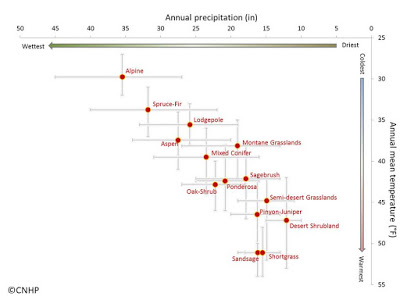By Karin Decker
The Conservation Planning Team at CNHP works on a number of projects that evaluate the potential effects of future climate conditions on Colorado’s species and ecosystems. As part of this work, we need to know what current climate conditions are. Here’s a look at the current “bioclimatic envelope” for Colorado’s major terrestrial ecosystems as described by average annual temperature and precipitation.
 |
| Bioclimatic envelope as represented by annual precipitation and mean temperature for ecosystems in Colorado. Error bars represent the 10-90% range around the mean. |
Desert shrubland occupies the driest bioclimatic envelope, while sandsage and shortgrass prairie are the warmest. Statewide, ponderosa pine forest, oak-shrubland and sagebrush shrubland are closely related in bioclimatic space, and show substantial overlap with the warmer and drier pinyon-juniper woodlands and semi-desert grassland. Above these warm and dry types, mixed conifer, aspen, and lodgepole forest share a mid-elevation envelope with montane grasslands. The coldest, wettest environments are occupied by alpine types, with spruce-fir forest nearby in bioclimatic space.
Although a warmer future appears certain, everything else is much more complicated!




